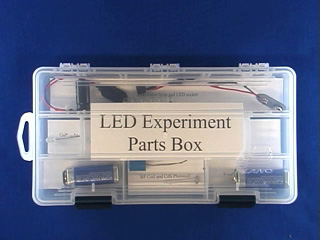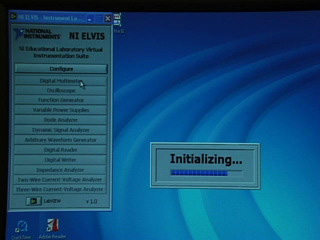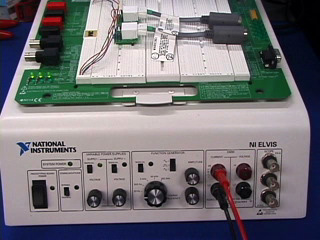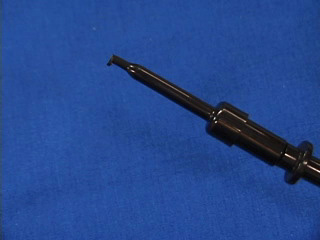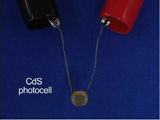
Periodic Properties and Light Emitting Diodes
This experiment was written by Arthur B. Ellis and Lynn Hunsberger, Department of Chemistry, University of Wisconsin-Madison, Madison, WI 53706 and George C Lisensky, Department of Chemistry, Beloit College, Beloit, WI 53511. Adapted with permission from Teaching General Chemistry: A Materials Science Companion. © 1993 American Chemical Society. Adapted by S.Michael Condren, Department of Chemistry, Christian Brothers University, Memphis, TN 38104 for measurements with National Instruments' LabVIEW and Educational Laboratory Virtual Instrumentation Suite (NI ELVIS).
In this experiment you will relate observed properties such as the color, wavelength and energy of light, and excitation voltage for a series of compound semiconductors to composition and periodic trends. In addition, you will observe how electrical resistance of a metal changes with temperature and how electrical resistance of a semiconductor changes under illumination. A key objective of this experiment is to relate the solid-state structure to physical properties of these materials.
| Procedure | Wear eye protection |
Thermal gloves recommended |
Caution: liquid nitrogen is extremely cold. Do NOT allow it to come into contact with skin or clothing, as severe frostbite may result. |
When you open the box with "Periodic Properties and Light Emitting Diodes " on top, this is what you will see. Please note where pieces are so that you are able to return them in the correct place when you are finished. Use the Mouse to click on the ELVIS icon on the computer screen to start the program. After the ELVIS software is loaded, click on the Digital Multimeter button to initialize it. Click on the Diode Tester button, labeled |>|.
Plug the Red lead into the Current HI and the Black lead into the Current LO. For making the measurements, the black lead has a spring loaded clip. By pulling on the extensions on the side of the lead, a small clip becomes visible. Remove the LED Color Strip from the parts box. Measure the voltage across a LED by placing the black lead of the NI ELVIS Digital Multimeter to TP1 and the red lead to TP6 for D5, TP5 for D4, TP4 for D3, TP3 for D2, TP2 for D1, and TP7 for D6. The band gap energy is displayed on the computer screen as you touch each test pin. Resistance measures the difficulty with which an electron moves through a material. Use a digital voltmeter on the resistance setting (200 Ω) to record the resistance of a copper RF coil. The small resistance to electrical current (flow of electrons) in metals is due to vibrations of the atoms that interfere with the flow of electrons. Dip the copper RF coil into liquid nitrogen. Caution: liquid nitrogen is extremely cold. Do NOT allow it to come into contact with skin or clothing, as severe frostbite may result. Did the resistance change? Use a digital voltmeter on the resistance setting (2000 Ω) to record the resistance of a CdS semiconductor photocell. Cover the photocell with your hand to block out most of the light. Does the resistance change with light exposure? Do not dip the photocell in liquid nitrogen; the plastic casing will crack!
LED Parts Box
Plano Utility Box
WalMart, #2-3500, $1.89 ea.
Diffraction Grating, Flinn C-Spectra
Flinn Scientific, #AP1714, $14.95 per 8" x 10" sheet.
Battery, 9 Volt
Red Super Bright Water Clear T-1 3/4 LED
Mouser Electronics, #512-MV8112, $0.20 ea in lots of 100.
Orange Super Bright Water Clear T-1 3/4 LED
Mouser Electronics, #512-MV8713, $0.38 ea in lots of 100.
Yellow Super Bright Water Clear T-1 3/4 LED
Mouser Electronics, #512-MV8313, $0.38 ea in lots of 100.
Green Super Bright Water Clear T-1 3/4 LED
Mouser Electronics, #512-MV8412, $0.29 ea in lots of 100.
Blue Water Clear T-1 3/4 LED
Mouser Electronics, #606-CMD383UBC/H2, $2.52 ea.
White Water Clear T-1 3/4 LED
Mouser Electronics, #606-CMD333UWC, $3.02 ea.
Economy Encapsulated RF Choke
Mouser Electronics, #43LJ415, $1.18 ea.
CdS Photocell
Jameco Electronics, #202403, $1.49 ea.
1.0 kΩ Battery Clip Circuit, (see below)
1.0 MΩ Battery Clip Circuit, (see below)
Battery Clip Circuits (one with 1.0 kΩ resistor and one with 1.0 MΩ resistor)
Battery Clip, Molded, 6 inch Leads
Mouser Electronics, #123-7016, $0.83 ea.
1.0 kΩ 1/4W Carbon Film Resistor
Mouser Electronics, #291-1K, $0.009 ea in lots of 200.
1.0 MΩ 1/4W Carbon Film Resistor
Mouser Electronics, #291-1M, $0.009 ea in lots of 200.
SIP Break-A-Way Socket, 10 Pin Strip (break off in pair)
Mouser Electronics, #506-510-AG91D, $2.00 ea.
Heat Shrink Tubing
Radio Shack, #278-1627, $2.39 pk.
Other Materials
Liquid Nitrogen
Polystyrene Coffee Cup
Multimeter, Model 26833-00
Cole Parmer, #EW-26833-00, $68.25 ea.
Alligator Clip Adapters
Radio Shack, #270-354, $2.99 pr.
University of Wisconsin Materials Research Science and Engineering Center
Interdisciplinary Education Group | MRSEC on Nanostructured Interfaces
This page created by S. Michael Condren, Christian Brothers University Memphis TN. Last modified June 16, 2013 .
